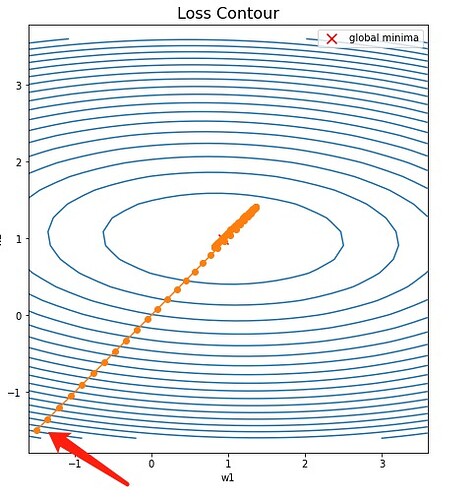Hi Youlong!
Looking at the original Adam paper linked to in pytorch’s
Adam documentation, I believe this is the way Adam is
supposed to work. (I have not looked at pytorch’s Adam
implementation.)
Quoting from the abstract of the Adam paper:
The method … is invariant to diagonal rescaling of the gradients
Note, that the direction of the gradient in some sense “washes out”
is portrayed as a desirable feature of Adam.
(Some suggestive terminology: The “m” in “Adam” refers to “moment”
rather than “momentum.” It is true that Adam "accumulates moments,
but in its very first step it moves a a direction that scales like
gradient / sqrt (gradient**2), which is to say, it does not
(necessarily) move in the direction of the gradient.)
We can verify that this behavior is displayed by pytorch’s Adam:
>>> import torch
>>> torch.__version__
'1.9.0'
>>> def fs (t):
... return (t * t * torch.tensor ([1.0, 1.0])).sum()
...
>>> def fa (t):
... return (t * t * torch.tensor ([2.0, 0.5])).sum()
...
>>> tss = torch.tensor ([1.0, 1.0], requires_grad = True)
>>> tsa = torch.tensor ([1.0, 1.0], requires_grad = True)
>>> tas = torch.tensor ([1.0, 1.0], requires_grad = True)
>>> taa = torch.tensor ([1.0, 1.0], requires_grad = True)
>>> sgds = torch.optim.SGD ([tss], lr = 0.1)
>>> sgda = torch.optim.SGD ([tsa], lr = 0.1)
>>> adas = torch.optim.Adam ([tas])
>>> adaa = torch.optim.Adam ([taa])
>>> fs (tss).backward()
>>> tss.grad
tensor([2., 2.])
>>> fa (tsa).backward()
>>> tsa.grad
tensor([4., 1.])
>>> fs (tas).backward()
>>> tas.grad
tensor([2., 2.])
>>> fa (taa).backward()
>>> taa.grad
tensor([4., 1.])
>>> sgds.step()
>>> tss
tensor([0.8000, 0.8000], requires_grad=True)
>>> sgda.step()
>>> tsa
tensor([0.6000, 0.9000], requires_grad=True)
>>> adas.step()
>>> tas
tensor([0.9990, 0.9990], requires_grad=True)
>>> adaa.step()
>>> taa
tensor([0.9990, 0.9990], requires_grad=True)
Here, fa (t) is a function that has a larger gradient in the t[0]
direction than in the t[1] direction (while fs (s) is symmetrical).
But you can see that Adam takes a step directly toward the origin
(the minimum), and this is not in the direction of the gradient of
fa (t). (By way of comparison, the steps taken by SGD are in
the direction of the gradient.)
Best.
K. Frank
